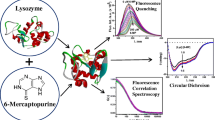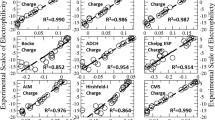Abstract
The water-assisted hydrolytic deamination mechanism of adenine was studied using density functional method at B3LYP/6-311G(d,p) level. Intrinsic reaction coordinate (IRC) calculations were performed on the transition states to verify whether it is the real transition states that connect the corresponding intermediates. Single-point calculations were carried out on the previous optimized geometries obtained during IRC calculations. The activation energies have also been calculated using G3MP2//B3LYP/6-311G(d,p) method. The water molecules attack the adenine and a tetrahedral intermediate forms. Then, two different intermediates have been obtained through different bond rotations. In pathway a, the second water molecule takes part in the formation of transition state and acts as a bridge to transfer hydrogen atom, while in pathway b, the second water molecule does not involve in the creation of transition state and only acts as a medium. The energy barriers are 23.40 and 37.17 kcal/mol for pathways a and b, respectively.





Similar content being viewed by others
References
Glaser R, Rayat S, Lewis M, Son MS, Meyer S (1999) J Am Chem Soc 121:6108–6119
Almatarneh MH, Flinn CG, Poirier RA, Sokalski WA (2006) J Phys Chem A 110:8227–8234
Labet V, Morell C, Grand A, Toro-Labbé A (2008) J Phys Chem A 112:11487–11494
Zhang A, Yang B, Li Z (2007) J Mol Struct (Theochem) 819:95–101
Almatarneh MH, Flinn CG, Poirier RA (2008) J Chem Inf Model 48:831–843
Zhu C, Meng FC (2009) Struct Chem 20:685–691
Becke AD (1993) J Chem Phys 98:5648–5652
Lee C, Yang W, Parr RG (1988) Phys Rev B 37:785–789
Miehlich B, Savin A, Stoll H, Preuss H (1989) Chem Phys Lett 157:200–206
Baboul AG, Curtiss LA, Redfern PC (1999) J Chem Phys 110:7650–7657
Curtiss LA, Raghavachari K (1998) J Chem Phys 109:7764–7776
Tang YZ, Sun JY, Sun H, Pan YR, Wang RS (2008) Theor Chem Acc 119:297–303
Frisch MJ, Trucks GW, Schlegel HB, Scuseria GE, Robb MA, Cheeseman JR, Montgomery JA Jr, Vreven T, Kudin KN, Burant JC, Millam JM, Iyengar SS, Tomasi J, Barone V, Mennucci B, Cossi M, Scalmani G, Rega N, Petersson GA, Nakatsuji H, Hada M, Ehara M, Toyota K, Fukuda R, Hasegawa J, Ishida M, Nakajima T, Honda Y, Kitao O, Nakai H, Klene M, Li X, Knox JE, Hratchian HP, Cross JB, Adamo C, Jaramillo J, Gomperts R, Stratmann RE, Yazyev O, Austin AJ, Cammi R, Pomelli C, Ochterski JW, Ayala PY, Morokuma K, Voth GA, Salvador P, Dannenberg JJ, Zakrzewski VG, Dapprich S, Daniels AD, Strain MC, Farkas O, Malick DK, Rabuck AD, Raghavachari K, Foresman JB, Ortiz JV, Cui Q, Baboul AG, Clifford S, Cioslowski J, Stefanov BB, Liu G, Liashenko A, Piskortz P, Komaromi I, Martin RL, Fox DJ, Keith T, Al-Laham MA, Peng CY, Nanayakkara A, Challacombe M, Gill PMW, Johnson B, Chen W, Wong MW, Gonzalez C, Pople JA (2004) Gaussian 03, revision D.01. Gaussian, Inc, Wallingford, CT
Toro-Labbé A (1999) J Phys Chem A 103:4398–4403
Rincón E, Toro-Labbé A (2007) Chem Phys Lett 438:93–98
Sousa SF, Fernandes PA, Ramos MJ (2007) J Phys Chem A 111:10439–10452
Labet V, Morell C, Cadet J, Eriksson LA, Grand A (2009) J Phys Chem A 113:2524–2533
Acknowledgments
This work was supported by the basic research sustentation fund of cosmetics in vitro toxicology study from Chinese Academy of Inspection and Quarantine (No. 2007JK017) and Ph.D. foundation of Shandong Province (No. 2008BS02014).
Author information
Authors and Affiliations
Corresponding author
Electronic supplementary material
Below is the link to the electronic supplementary material.
Rights and permissions
About this article
Cite this article
Zheng, H., Meng, F. Theoretical study of water-assisted hydrolytic deamination mechanism of adenine. Struct Chem 20, 943–949 (2009). https://doi.org/10.1007/s11224-009-9495-z
Received:
Accepted:
Published:
Issue Date:
DOI: https://doi.org/10.1007/s11224-009-9495-z




